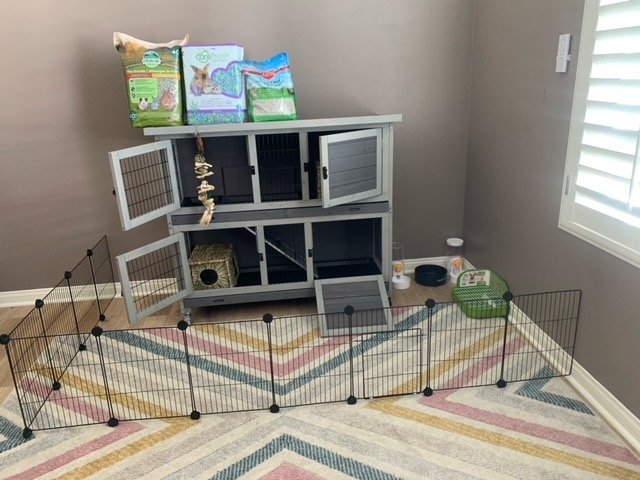Advantages of Pen Living
Housing your rabbit in an exercise pen (aka x-pen) is much more beneficial than housing your rabbit in a cage. X-pen living gives your rabbit more space, while still keeping them safely contained when you are not home or need to keep your rabbit enclosed. These are just a few of the benefits of pen living:
You get more space for your money (x-pens cost the same or less than most rabbit cages).
Your rabbit has more room to roam and feels “freer” while still in a safe place. Pens can be moved and configured in any shape to suit your available space.
X-Pens are easy to clean.
Your rabbit’s x-pen needs to have enough space for their litter box, water bowl and food dish, and a hidey house like a Cottontail Cottage (with at least two holes for entrance/exit). Make sure there’s also room for their toys, with enough space to stretch out, walk around, and stand up. If your rabbit is an escape artist, create a removable top with clean shade cloth (found in garden centers), or purchase a top from a pen manufacturer.
Rabbits can feel unstable and nervous on slippery surfaces, so make sure that the floor under your rabbit’s x-pen is covered with a non-slippery surface. Area rugs, carpet squares, towels, blankets, and sheets will help. A heavy-duty shower curtain can be placed underneath the towels or blankets as a leak-proof barrier to protect your flooring.
Example of Rabbit Living Spaces
Here’s a rabbit housing checklist to reference as you’re setting up an x-pen:
Large enough to accommodate your rabbit when full grown — 4’x4’ fits most breeds..
Large enough for your rabbit to stretch out, when all the necessary supplies (litter box, hidey box, water and food bowls) are inside.
Large enough for your rabbit to move around, in case they occasionally have to miss run time.
Gate/door is large enough for a large litter box to fit through.
Gate/door opens from the side, and not down, so your rabbit’s feet won’t get caught when entering or exiting.
The x-pen is tall enough for your rabbit to not jump over and/or you have a lid.
A Word on Cages
SDHRS recommends you give your rabbit as much space as possible in an x-pen or bunny-proofed room. A cage does not provide adequate space for a rabbit to be happy and comfortable, and does not leave enough room for all of the items a rabbit requires. Cage living can lead to boredom, disengagement, behavioral issues, cage aggression, and depression. For smaller rabbits, you can reinforce pen bars with grids that have smaller spacing between the fence wires to prevent escaping.
Some circumstances may make cage housing temporarily necessary, but this is not a healthy long-term solution. If you are moving and your rabbit’s living area isn’t set up for a few days, they will probably be OK in a roomy cage while you transition. Or perhaps you experience an emergency that briefly affects your housing situation. However, it is not humane to make rabbits live in cages long term.
If you have already bought a cage or hutch, consider setting up your x-pen around the cage or connect it to the cage like a fenced-in yard. Your rabbit can use this space to move around and as a place to be alone. Cover any wire bottom with rabbit-safe flooring, such as carpet squares.
Twiggy Binkying
Sage
Rabbits MUST have at least a few hours of playtime each day, to exercise and interact with you.
















